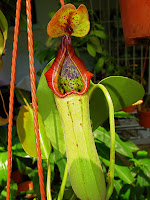











Before my foray into gardening and plants, the only bananas I knew of were those you would commonly find hanging at fruit stalls and supermarkets or those which were sold as goreng pisang (deep fried banana fritters). Needless to say, I was somewhat surprised and amazed when I found out that there are in fact more than 50 species of bananas (scientifically known by the genus "Musa") all over the world, and not all of them are fruiting / edible bananas.
Apart from being just a regular food source, some bananas are often grown for their ornamental value, either for their large showy inflorescences or their striking foliage. No tropical garden is complete without at least a banana plant in sight. This probably explains ornamental bananas are now getting more attention and increasingly being incorporated into our public spaces, condominium landscape and private gardens. There has also been a recent surge in interest amongst collectors for these plants, with serious and amateur collectors (like myself) alike going about their rounds in just about every nursery in Singapore, searching for the more elusive and exotic banana species.
The most commonly grown ornamental banana species include the Blood Banana (Musa zebrina / sumatrana / acuminata), Musa ornata, Musa laterita, Musa uranoscopus (formerly M. coccinea) and Musa velutina (pink or self-peeling banana). The rarer ones would include the Musa siamensis and in particular, the Musa becarrii (pictured here as the white and purple inflo.) which I have yet to find anywhere. There are two others which used to be fairly rare but which have now lost its demi-God status due to readier availability are the Thai Red and the variegated Musa. For some reason or other, they did not do too well under my care and sadly, both did not manage to survive. A fellow collector gave me a Hawaiian black musa which sadly, also did not survive. Hence, contrary to popular belief, not all bananas are easy to grow.
If you are thinking of growing ornamental banana, be sure to pick one which is relative to the size of your garden. These plants are invasive (esp. M. laterita which has runners) and if well established, can multiply fairly quickly into large clumps, to the point of becoming a nuisance. Also, I would recommend that bananas which are grown primarily for their foliage are grown in an area which is sheltered from the wind as the leaves are vulnerable to being torn. Finally, I find that ornamental bananas do best in bright light but not necessarily under direct afternoon sun as the colour of the leaves tend to get washed out or are prone to getting scorched. Apart from that, have fun going bananas!




























































